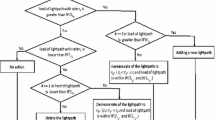Abstract
Multilayer traffic engineering (MLTE) serves to provide cross-layer online network optimization techniques to cope with rapid variations and short-term evolutions in traffic patterns. MLTE extends traffic engineering as it exists in IP/MPLS-based technology toward the multilayer IP/MPLS-over-optical transport network. In addition to the IP/MPLS traffic routing, MLTE exposes much larger adaptation flexibility by building on next-generation automatic switched optical transport networks. These offer fast setup and teardown of end-to-end multi-hop optical connections (lightpaths), which are offered to the IP/MPLS layer as dynamically provisioned capacity. This dynamic nature leads to an IP/MPLS logical topology that can be reconfigured on the fly, and IP/MPLS link capacity that can be up- or downgraded as client traffic demand varies. These MLTE techniques are generally used to increase perceived network performance in terms of throughput or QoS. As such, a MLTE-managed network offers a better than best-effort service. Many types of traditional and novel services are shifting toward IP/MPLS technology. Consequentially, MLTE algorithms and strategies should be conceived with the characteristics of such services in mind. We present a MLTE strategy that can be implemented in a robust and distributed way. This strategy is then taken as the starting point in a study which evaluates its suitability to such services. We show how the strategy can be adapted considering service performance metrics such as end-to-end delay, traffic loss, and routing stability, and how such service optimizations impact general MLTE objectives such as IP/MPLS logical topology mesh size reduction.
Similar content being viewed by others
References
Berger, L., et al.: RFC 3471, Generalized Multi-Protocol Label Switching (GMPLS) Signaling Functional Description, Network Working Group (2003)
Optical Internetworking Forum: UNI 2.0 Signaling Specification—oif2003.293 (2003)
Xiao X. et al.: Internet QoS, a big picture. IEEE Netw. Mag. 13(2), 8–18 (1999). doi:10.1109/65.768484
ITU-T: E.800: Terms and Definitions Related to Quality of Service and Network Performance Including Dependability (1994)
Takeda, T., et al.: Optical VPN architecture and mechanism. In: Proceedings of the 9th Asia-Pacific Conference on Communications, Wuhan, China, vol. 2, pp. 751–755 (2003)
Cinkler, T., et al.: Fairness Issues of Routing with Grooming and Shared Protection. In: Proceedings of 8th IFIP Working Conference on Optical Network Design and Modelling (ONDM), Ghent, Belgium, pp. 665–668 (2004)
Cinkler, T., et al.: λ-path fragmentation and de-fragmentation through dynamic grooming. In: Proceedings of 7th International Conference on Transparent Optical Networks (2005), Barcelona, Spain, vol. 2, pp. 1–4 (2005)
Iovanna P. et al.: A traffic engineering system for multilayer networks based on the GMPLS paradigm. IEEE Netw. 17(2), 28–37 (2003). doi:10.1109/MNET.2003.1188284
Gillani, B., et al.: Topology reconfiguration mechanism for traffic engineering in WDM optical network. In: Proceedings of 19th Symposium on High Performance Computing Systems and Applications, Guelph, Ontario Canada, pp. 161–167 (2005)
Puype, B., et al.: Multi-layer traffic engineering in data-centric optical networks, illustration of concepts and benefits. In: Proceedings of COST266/IST OPTIMIST Workshop—7th IFIP Working Conference on Optical Network Design and Modelling, Budapest, Hungary, pp. 211–226 (2003)
Puype, B., et al.: Optical cost metrics in multi-layer traffic engineering for IP-over-optical networks. In: Proceedings of 6th International Conference on Transparent Optical Networks, Wroclaw, Poland, vol. 1, pp. 75–80 (2004)
Puype, B., et al.: Influence of multilayer traffic engineering timing parameters on network performance. In: IEEE International Conference on Communications (ICC 2006), Istanbul, Turkey, vol. 6, pp. 2805–2810 (2006)
ITU-T: Rec. G.7043, Virtual Concatenation of PDH Signals (2006)
ITU-T: Rec. G.7042/Y.1305, Link Capacity Adjustment Schemes (LCAS) for Virtual Concatenated Signals (2006)
Szymanski A. et al.: Grade-of-service-based routing in optical networks. IEEE Commun. Mag. 45(2), 82–87 (2007). doi:10.1109/MCOM.2007.313400
Van Breusegem E. et al.: Evaluation of ORION in predimensioned networks. In: Proceedings of 19th International Teletraffic Congress, Beijing, China, vol. 6b, pp. 1265–1274 (2005)
IST FP6-027305 NOBEL 2 integrated project. http://www.ist-nobel.org/
Author information
Authors and Affiliations
Corresponding author
Rights and permissions
About this article
Cite this article
Puype, B., Colle, D., Pickavet, M. et al. Multilayer traffic engineering for multiservice environments. Photon Netw Commun 18, 150–159 (2009). https://doi.org/10.1007/s11107-008-0179-1
Received:
Accepted:
Published:
Issue Date:
DOI: https://doi.org/10.1007/s11107-008-0179-1




